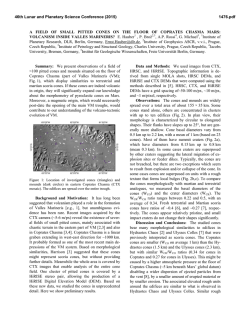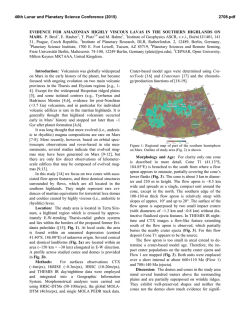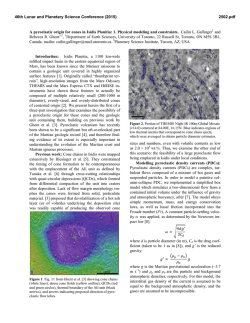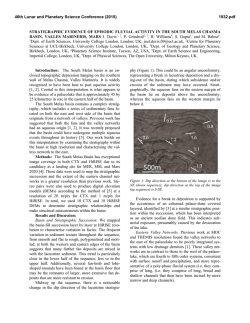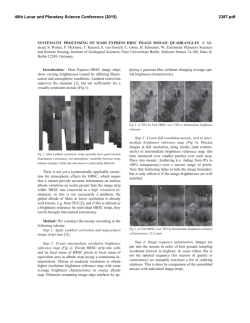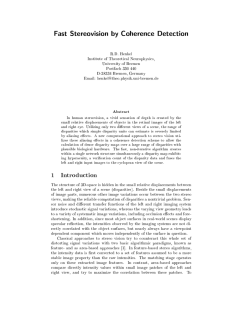
THE SHAPES OF SCORIA CONES ON MARS: DETAILED
46th Lunar and Planetary Science Conference (2015) 1753.pdf THE SHAPES OF SCORIA CONES ON MARS: DETAILED INVESTIGATION OF THEIR MORPHOMETRY BASED ON HIRISE AND CTX DTMS. P. Brož1,2, O. Čadek3 E. Hauber4 and A. P. Rossi5, 1 Institute of Geophysics ASCR, v.v.i., Prague, Czech Republic, [email protected], 2Institute of Petrology and Structural Geology, Charles University, Czech Republic 3Charles University, Faculty of Mathematics and Physics, Department of Geophysics, V Holešovičkách 2, 180 00, Prague, Czech Republic, [email protected] 4 Institute of Planetary Research, DLR, Berlin, Germany, [email protected], 5 Jacobs University Bremen, Campus Ring 1, 287 59, Bremen, Germany, [email protected]. Introduction: The existence of scoria cones was suggested for several regions on Mars [1-4]; and at least in three cases they form volcanic fields: Ulysses Colles (UC) [4], Hydraotes Colles (HC) [3] and unnamed field in Coprates Chasma (CC) [5,6]. Although the interpretation of these edifices as scoria cones was mainly based on their morphological similarity with terrestrial analogues, no detailed investigation of their morphometry was performed to support such conclusion, with the only exception of the Ulysses Colles cone field [4]. However, this study was based on data obtained from High Resolution Stereo Camera data (HRSC) which have a resolution that is of limited use for the investigation of km-sized landforms. Hence, these results came with some degree of uncertainty. Therefore, we decided to use newly available highresolution digital elevation models (DEM) based on HiRISE and CTX stereo image pairs to investigate cones within three hypothesized volcanic fields and to compare the results between these fields. We test if there are similarities in morphometry and shapes. Such comparison has the potential to provide additional criteria how to distinguish their formational mechanisms, and eventually to indirectly confirm their volcanic origin. Data: We used topographic data derived from HiRISE (~30 cm/pixel, [7n]) and CTX (5–6 m/pixel; [8]) stereo images. High-resolution DEM were computed from HiRISE and CTX stereo pairs using the methods described, e.g., in [9], and accurate with single shot data from the MOLA PEDRs. HiRISE and CTX DEM reach a spatial resolution of ~1 m/pixel and ~10 m/pixel, respectively, and the vertical accuracy of the stereo-derived DEM can be roughly estimated to be around few meters. The delineation of the volcano shape in plan view was done by numerical tracing where the slope exceeds 1°. Results: To carry out this study we processed 8 stereo image pairs (5 HiRISE, 3 CTX). This allows us to investigate 28 conical structures within three fields. 17 cones are covered by HiRISE DEMs, 11 by CTX DEMs. In all fields, only a subset of cones is investigated as none of the fields is completely covered with stereo data of sufficient quality. As individual cones display morphologic inhomogeneities, we determine for each cone the average shape (Fig. 1) and measure the basic morphometric values: basal diameter, crater diameter, maximum height, volume and average and maximum flank slope. Fig. 1: Normalized height versus average slope (°) for several cones within the UC and HC fields. Profiles based on HiRISE and CTX DTMs (marked in legend). Cones between the fields are similar in shape. 0 corresponds to 0 % and 1 to 100% of the real height. Discussion: The results of our measurements are shown in Fig. 2. They allow investigating the similarities and differences between the studied cone fields. From a morphometric perspective, the cone flanks in HC are similar to those in UC (Fig. 1), even though the HC cones are generally smaller in diameter, lower, and thus less voluminous than the UC cones. Cones in both fields rise gradually from the surrounding units and are steepest in the second third of profile and then in vicinity of the central crater, average slope angles decrease. Unfortunately, the data for cones in CC are not of sufficient quality to investigate the relation of average slopes to the height over the entire length of the profiles as data shows large oscillations. Only the average slopes could be determined in CC, but as visible on Fig. 2, the cones have similar volumes/sizes as cones in HC, and also similar average slopes. The investigated cones flanks in all fields do not reach average values higher than 25°, in fact, most of the average values are below 20° (Fig. 2b). The maximum slopes mostly range from 20° to 27° (Fig. 2c). Such values are consistent with the previous prediction [10] that the angle of repose for scoria cones is commonly not reached on 46th Lunar and Planetary Science Conference (2015) 1753.pdf Fig. 2: Plots show several dependencies within individual cones as within various fields too based on HiRISE and CTX DTMs. a) volume versus height b) average slope of flanks versus height and c) maximum slope of flanks versus height. Mars. We also found that the values (e.g., height) based on HRSC DTM measurements [4] were partly overestimated and cones in UC are slightly smaller than previously thought. We also test the hypothesis that the cones in HC and CC were formed by volcanic low-energetic eruptions, similar to the formation of cones in UC [4,10]; Fig. 3a]. If the shapes of cones in HC and CC can be explained by ballistic emplacement (Fig. 3b,c), this provides additional hints at the mechanism of their formation. We find out that the calculated average shapes of cones can be explained with a good match (mostly less than <10 meters) by ballistic emplacement, even though cones in HC and CC seem to be distinct from the cones in UC (Figs. 2a,b). We find out that to reconstruct cones shapes in UC, HC and CC, the initial velocities of ejected particles typically have to be in the range of 50 m/s to 140 m/s, and particles diameters need to range between 1 mm and 5 mm. However, when the current atmospheric pressure, which varies between the fields, is taken into account, the individual fields show some differences in these parameters. The mean values for individual fields are the following: ~100 m/s and 1.8 mm for UC (based on 7 cones); 91 m/s and 1.8 mm for HC (based on 15 cones) and 84 m/s and 1.3 mm for CC (based on 6 cones). Such variations may be explained by less energetic eruptions and/or higher atmospheric pressure at the time of formation, which caused a deposition of ejected particles closer to the vent and hence partly different shapes of the cones between fields. Nevertheless, our findings are within the range of previously calculated values for cones in UC based on HRSC and CTX DTM, and consistent with theoretical predictions [11]. For this reason, we conclude that a volcanic hypothesis about the origin of the cones is consistent with the observed shapes. Acknowledgements: This study was partly supported by the Grant 580313 of the program of the Charles University Science Foundation GAUK Fig. 3:. Average profiles of several cones within three fields and results of numerical modeling of ballistic emplacement based on [10]. As visible, model is able reconstruct observed shapes with error less than 10 meters. References: [1] Bleacher et al. (2009), JVGR 185, 96–102 [2] Keszthelyi et al. (2008), JGR 113, E04005 [3] Meresse et al. (2008), Icarus 194, 487-500 [4] Brož and Hauber (2012), Icarus 218, 88-99 [5] Harrison and Chapman (2008), Icarus 198, 351–364 [6] Hauber et al. (2015) LPSC, XLVI, Abstract #1476. [7] McEwen et al., (2007), JGR, 112, E05S02 [8] Malin et al., (2007), JGR 112, E05S04 [9] Moratto et al. (2010), LPSC, XLI, Abstract #2364 [10] Brož et al. (2014), EPSL 406, 14-23 [11] Wilson and Head (1994). Rev. Geophys. 32, 221–263.
© Copyright 2026
